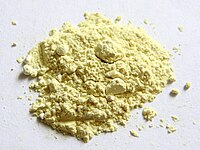
Photo from wikipedia
Abstract In this study, pure and Nickel doped α-Bismuth oxide (Ni-Bi2O3) powder were synthesized by simple chemical precipitation method. The resulting samples were analysed using SEM, EDAX, XRD, FTIR, UV–visible,… Click to show full abstract
Abstract In this study, pure and Nickel doped α-Bismuth oxide (Ni-Bi2O3) powder were synthesized by simple chemical precipitation method. The resulting samples were analysed using SEM, EDAX, XRD, FTIR, UV–visible, PL and TRPL spectroscopy techniques. EDX and XRD results indicated that Ni was incorporated into the framework of the α-Bi2O3. The SEM characterizations revealed rod shape microstructures of the undoped Bi2O3 sample, while the Ni-doped product consisted of distorted or broken rod microstructures. Photo electrochemical (PEC) study plainly demonstrated the improved photo current density for Ni-doped sample compared to its pure counterpart. The photocatalytic activities of these samples were evaluated on the degradation of Methylene Blue under irradiation of simulated solar light. The Density Functional theory (DFT) study clearly revealed the formation of intensified energy state level in Ni-Bi2O3, supported by PL and UV, which was responsible for the high PEC and photocatalytic efficiency. The experimental results supported theoretical outcomes to conclude that Ni dopant serves as shallow trapping energy sites for photo excited charge carriers and greatly enhances the photoactivity of the catalyst.
Journal Title: Solar Energy Materials and Solar Cells
Year Published: 2018
Link to full text (if available)
Share on Social Media: Sign Up to like & get
recommendations!